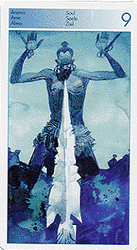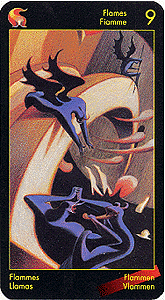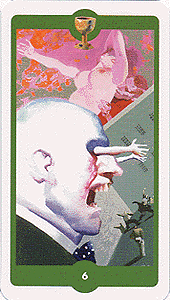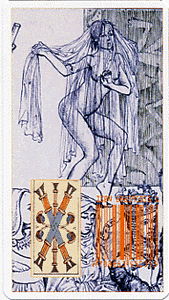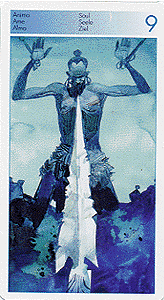Carrying the Torch of Tarot's Italian Legacy: A Tarot Garden Interview with Lo Scarabeo's Riccardo Minetti
Posted by Riccardo Minetti, Jeannette Roth on Oct 8th 2018
This interview was conducted in 2002, and is finally being ported over from our old website. Although the article is now more than fifteen years old, Mr. Minetti's insights remain as fascinating and relevant today as they were a decade-and-a-half ago. Those familiar with Lo Scarabeo's contemporary business model and products should find this "time capsule" to be particularly enlightening.
In his Encyclopedia of Tarot, vol. I, President of U.S. Games Systems and noted tarot authority Stuart Kaplan writes: "There exist today several fifteenth-century Visconti-Sforza tarocchi decks which comprise the earliest known tarot cards... Italy holds the honor of having produced several of the earliest known tarocchi packs that contain the mystical and allegorical trump cards."
In other words, when it comes to the documented history of tarot, we see that the Italians have played an early, and pivotal, role in the development of these entertaining and mystical cards. From the original Visconti cards attributed to artist Bonafacio Bembo; to Dotti, Mitelli, and the other Italian card manufacturers of the eighteenth and nineteenth centuries; through such modern card manufacturers as Dal Negro, Edizione del Solleone, and il Meneghello -- Italy has always been home to some of the most influential contributors to the world of tarot.
One relative newcomer to the world of Italian tarot publishers is Lo Scarabeo. Founded by Piero Alligo and Mario Pignatiello in 1987, Lo Scarabeo has quickly emerged as one of the world's premier tarot publishing houses. With its products currently being distributed to every corner of the globe, the name "Lo Scarabeo" has become as well-known among tarot enthusiasts as those of long-time industry giants U.S. Games Systems and AGMüller.
We recently had the honor of corresponding with Riccardo Minetti -- one of Lo Scarabeo's editors, and a contributor to several Lo Scarabeo tarot products. Mr. Minetti graciously agreed to provide us with the following interview, which we are pleased to present here for our website visitors.
Q: What is your role at Lo Scarabeo?
A: If I had to describe it in one phrase, I would say "Chief Editor." But that title doesn't mean very much. Lo Scarabeo is a very small company with very few persons, and everyone does a little bit of everything. I frequently work as a graphic designer as well; at other times, I am responsible for marketing and public relations.
I would say that the skills that I most often use in my job are my knowledge of Tarot and my experience with computers.
Q: Many of Lo Scarabeo's current popular 78-card tarots were originally published as limited-edition 22-card tarots, as part of various collectors' series (d'Arte, Fantastico, Antico). Can you explain how the types of products produced by Lo Scarabeo have "evolved" over the years?
A: The answer is "cost." To produce a 78-card deck, one needs over three times the money than is required to produce a 22-card deck. When Lo Scarabeo started, we didn't have the resources to commit ourselves to 78-card decks. Besides, the market was very different then, and it was commonly acceptable to use and read with a majors-only deck. Nowadays, I think that most of the people who have interest in 22-card decks are collectors.
The transition from 22-card decks to 78-card decks may be a sign of a deeper transition between art -- that is, Tarot as a collector's item -- and Tarot "proper," which is of interest to a wider audience.
Q: Does Lo Scarabeo have any plans to publish any limited-edition collectors' decks again in the future?
A: Every Lo Scarabeo deck will also be published as a limited edition deck. But creating decks that are solely intended as collector's items is not in our present plans.
Q: Does Lo Scarabeo publish products other than tarots and cartomantic decks?
A: Of course -- but most of the Lo Scarabeo's sideline products are not sent to the international market. Our additional product lines consist primarily of books of comic art, illustrations, and criticism of art. The barrier, of course, is language. Books in Italian are very difficult to sell in the United States, for instance.
Recently, Lo Scarabeo published Arcana Mater, a graphic novel whose meaning and significance is linked to Tarot. And in November, we will begin a new label, Alta Fedeltà [High Fidelity], under which we will publish some very interesting art books for the Italian market.
Q: Which Lo Scarabeo title(s) are among your personal favorites?
A: I have to draw a line between the decks I created (or helped to create) and the ones I just personally like. The former are part of me. I'm not objective about them, as they speak with my voice.
Among the decks I have worked on, I certainly love the Tarot of Imagination. It is not a traditional Tarot, but that just adds to the importance and beauty of the deck. I would call it a meditative deck, and I would suggest that people employ it for personal use, rather than using it to perform readings for a querent. It sort of reminds me of what I feel when approaching the I-Ching.
The deck I'm almost sure it will became my favorite, and my day-to-day reading deck, will be the Fey Tarot that will be published in October. That may be, in my opinion, among the best decks in many years.
Among the Lo Scarabeo decks that I never personally worked on, I'm fond of the Tarot of the Origins and the Dante Tarot. The first has a primal power that really challenges my mind and soul when using it. The second is so beautiful I just feel better looking at the cards. I have never really been able to read with the Dante, as my mind is too drawn inside the art.
Q: What title(s) do you personally consider to be among the most unusual decks published by Lo Scarabeo?
A: I should reply by asking what you mean by "unusual."
I think that some of our decks have tried to "move forward"... to evolve... and to say something as yet unsaid in Tarot. One of them is certainly the Tarot of the III Millennium. But the result, while terribly interesting to an expert or to a scholar, is not very good for readings. Too intellectual, too artificial...
Lo Scarabeo produces between six and ten decks every year. I think it is very important that at least one of those decks is "experimental" in nature. Publishers should also take it upon themselves to assume part of the burden of research for any deck they produce.
Q: Your comments about the III MillenniumTarot are interesting. Can you tell us more about this deck?
A: What I mean about the III Millennium is that it is incomplete.
Tarot should be able to be easily accessible and intuitive. The approach taken by the III Millennium imagery is very intellectual, and therefore somewhat difficult. It is a deck I use to study Tarot, when I have a pen and paper to take notes. Unless one is very good with Tarots, they will find the deck incredibly difficult to work with in readings.
In that deck, there are three very interesting concepts:
1. The puzzle. All of the minor arcana are fragments of wider pictures. There are missing parts, just as there are redundancies. This approach provides incredible possibilities for reading, especially now in the "Third Millenium," where human psychology is often forced to deal with fragmentary experiences. But it is difficult and confusing if one is used to reading the standard, static symbology that is typically found in Tarot.
2. The conflict and the distance between spirituality and materialism. This is the key to many of the difficulties in current society in my opinion, and often underlies our everyday problems.
3. Abstraction. The deck forces an element of abstraction upon readers, which places an additional burden upon them. My comment that the III Millennium was not a "good" experiment arises from the realization that we couldn't make that deck all it is now, and also make it simple and communicative without a tremendous effort. My job sometimes makes me see decks not just as they are, but also as they may have been.
I really would call the III Millennium Tarot an "advanced deck," and I would discourage beginners from using it. Most customers of Tarot Garden are not beginners, so they may be thrilled by the challenge the deck provides -- but it's better if they know in advance what they will find.
Q: Are there any special challenges in preparing a deck to be distributed to both the European and North American markets?
A: It is not just the North American and European market. It's much more complex.
There is a market of collectors, of people who already knows a lot about Tarot and who own more than one deck. They came from a wide variety of cultures -- from Korea, to the United States, to Scandinavia, to Italy, to the Mediterranean countries. Then there is a market of people who are just curious about Tarot. And then another market of "professional readers."
The real challenge is that we don't have any direct contact with our customers. Many things change from the United States to Italy, but the greatest challenge is not in catering to two different "worlds," but rather to have a perception of who is really buying our Tarots, and why.
Q: The Rider-Waite deck revolutionized tarot in the 20th century. Do you see any similar revolutionary changes occurring for Tarot in the 21st century?
A: I am actually rather pessimistic. While the Rider-Waite is probably still the best single deck one may work with, it is working like an anchor, slowing down any evolution of the concept of Tarot. Every time a deck tries to go in a different direction, it is labeled as "wrong." You would be surprised to learn how many complaints we receive from North America, from people saying: "that deck is printed wrong, as Justice is 8 and Strength is 11. I want a copy that is printed right."
Once a Tarot expert -- I don't remember the name -- told me that it is bound to be a cycle of synthesis and complexity, and that we are now in the "complexity" part of the cycle. So it should be expected that in the future, the number of decks will not continue to increase, and the "new Rider-Waite" will come.
I'm not sure of this, because the Rider-Waite was the first "divination deck for everyone." It synthesized tarot concepts in a new way, and did not have to compete against a sea of other tarot divination decks for attention. In contrast, a "new" Rider-Waite (that is, some future tarot that would have the same revolutionary impact as the Rider-Waite) would have to fight its way among hundreds of other decks -- like speaking in noisy, crowded room -- to get noticed. Additionally, it would have to fight against the conservatism and preconceived notions of every society - Tarot society, too. If-and-when a new greatdeck comes, it will be something that will be able to capture what has changed in human spirituality in over a century of deep transformations.
The two greatest limitations of the Rider-Waite-Smith decks are:
1) Unquestioning reliance on Waite's symbology. Evolution in psychology, knowledge of oriental philosophies, and an overall greater level of education should bring much more to the experience of Tarot than was possible in Waite's time. Today's Tarot could potentially have more to offer for meditation, inner exploration, and other evocative approaches.
2) Waite's nineteenth-century perspective. Human spirituality, if not human nature, has changed. Many decks have simply adapted these changes to the RWS structure -- I think that it is not enough
Q: What are your personal feelings about tarot as an "art form?" Do you think that it is always necessary for a tarot to include meaningful symbolism, or do you think that there is value in a tarot that strives for nothing more than sheer artistic beauty? (Here, we acknowledge that it is possible for a tarot to have both, but are asking if it is necessary.)
A: I think it is necessary for Tarots to have meanings. However, the meaning does not necessarily have to be symbolic in nature. I think that if you remove meaning from Tarot cards, however it might structured or conveyed, then you no longer have a Tarot. You just have an illustration on a card.
What makes the difference is that art allows more ways for meanings to be expressed beyond a standard symbolism: i.e., "this means this" and "that means that." Tarots are important because people use them. However, they do not necessarily use them for reading. They may use them for many other purposes, such as studying, meditation, and self-exploration. Having art without meaning will make decks useless.
Q: In general, what kinds of things (products, changes, etc.) can we expect to see from Lo Scarabeo in the near future?
A: In 2003 and 2004, Lo Scarabeo should complete and publish many decks of great impact. After that, it will be a time to examine the results produced by our efforts.
I'm very curious about how people will respond to our latest decks. Very, very curious indeed.
The Tarot Garden is proud to include the Lo Scarabeo line of tarot products in our online catalog. Click here for a listing of Lo Scarabeo titles documented in our database -- many of which are available for purchase.
© Riccardo Minetti and Jeannette Roth
1 August 2002

